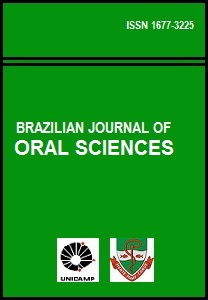Abstract
The purpose of this study was to evaluate the endurance time, pain and discomfort intensities, the RMS and median frequency (Fmed) in the induced fatigue by prolonged gum mastication in control and temporomandibular disorders (TMD) groups. This study evaluated 8 healthy and 11 TMD patient women (mean age 27±6 years). Each gum (18x17x4mm, weight 245mg) was put on both sides of the dental arc. The metronome set at 80 bpm indicated chewing rate. Endurance time corresponded to time ranging from beginning of mastication to the subject fatigue. Pain and discomfort intensities were evaluated by visual analogue scale (VAS) obtained after and before the prolonged gum mastication. Surface EMG was recorded from the anterior temporalis and masseter muscles using surface differential electrodes (silvers bars 10mm apart, 10mm long, 2mm wide, gain of 100x, input impedance of 10GÙ and CMRR of 130dB). The EMG signals were analogically amplified with gain of 50x, filtered (10-1500Hz bandpass) and sampled by 12 bits A/D covert board with a 2KHz frequency. The signals were digitally band-pass filtered (10-500Hz). The RMS and Fmed (PSD, FFT, 250 ms, 1024 points, Hanning window processing) were obtained from masticatory cycles in 250ms windows determined visually considering the most stable epoch. The maximal clenching RMS values were used to normalize masticatory cycles EMG amplitude. The first masticatory cycle Fmed values were used to normalize EMG frequency of masticatory cycle remains. There were no significant differences among the values of RMS and Fmed during the prolonged gum mastication (p>0.05, Friedman ANOVA). Endurance time was significantly shorter to TDM group (p>0.05, Mann-Whitney test). Pain and discomfort intensities were not different for control and TDM groups after the prolonged mastication (p>0.05, Mann-Whitney test). There was no evidence of change related to prolonged gum mastication in the investigated electromyographic parameters, in these experimental conditions.References
Barker GR, Wastell DG. The effect of aftigue on the silent period of the masseter electromyogram. J Dent. 1988; 16: 71-5.
Dahlström L. Electromyographic studies of craniomandibular disorderes: a review of the literature. J Oral Rehabil. 1989; 16: 1-20.
Svensson P, Bugaard A, Schlosser S. Fatigue and pain human jaw muscles during a sustained, low-intensity clenching task. Arch Oral Biol. 2001; 46: 773-7.
Von Lindern JJ, Niederhagen B, Berge S, Appel T. Type A botulinum toxin in the treatment of chronic facial pain associated with masticatory hyperactivity J Oral Maxillofac Surg. 2003; 61: 774-8.
De Luca CJ. The use of surface electromyography in biomechanics. J Appl Biomech. 1997; 13: 135-63.
Portney L. Eletromiografia e testes de velocidade de condução nervosa. In: Sullivan OS, Schmitz JT. Fisioterapia – avaliação e tratamento. São Paulo: Manole; 1993. p.183-223.
Merletti R, Knaflitz M, De Luca CJ. Electrically evoked myoelectric signals. Crit Rev Biomed Eng. 1992; 19: 293-340.
Oliveira AS. Caracterização multifatorial de uma população de portadores de desordens temporomandibulares [tese]. Piracicaba: Faculdade de Odontologia de Piracicaba,Universidade Estadual de Campinas; 2002. 157p.
Palla S, Ash M. Power spectral analysis of the surface electromiogram of human jaw muscle fatigue. Archs Oral Biol. 1981; 26: 547-53.
Kroon GW, Naeije M. Electromyographic evidence of local muscle fatigue in a subgroup of patients with myogenous craniomandibular disorders. Arch Oral Biol. 1992; 37: 215-8.
Maton B, Rendell J, Gentil M, Gay T. Masticatory muscle fatigue: endurance times and spectral changes in the electromyogram during the production of sustained bite forces. Archs Oral Biol. 1992; 37: 521-9.
Lindström L, Hellsing G. Masseter muscle fatigue in man objectively quantified by analysis of myoelectric signals. Arch Oral Biol. 1983; 28: 297-301.
Buzinelli RV, Berzin F. Electromyographic analysis of fatigue in temporalis and masseter muscles during continuous chewing. J Oral Rehabil. 2001; 28: 1165-7.
Lund JP, Widmer CG. Evaluation of the use of surface electromyography in the diagnosis, documentationand tratament of dental patients. J Craniomandib Disord. 1989; 3: 125-9.
Merletti R, Rainoldi A, Farina D. Surface EMG for non invasive muscle characterization. Exerc Sport Sci Rev. 2001; 29: 20-5.
Farella M, Bakke M, Michelotti A, Rapuano A, Martina R. Effects of prolonged gum chewing on pain and fatigue in human jaw muscles. Eur J Oral Sci. 2001; 109: 81-5.
Bates M, Petrich M, Stockden M. Posture, pathology, pain and performance. Bachelor of Applied Science Research Report. Perth Australia: Curtin University of Technology; 1989.
Tenenbaum G. Theoretical and practical considerations in investigating motivation and discomfort during prolonged exercise. J Sports Med Phys Fitness. 1996; 36: 145-54.
Price DD, McGrath PA, Raffi A, Buckingham B. The validation of visual analogue scales as ratio scale measures for chronic and experimental pain. Pain. 1983; 17: 45-56.
Christensen LV. Jaw muscle fatigue and pains induced by experimental tooth clenching: a review. J Oral Rehabil. 1981; 8: 27-36.
Masuda K, Masuda T, Sadoyama T, Inaki M, Katsuta S. Changes in surface EMG parameters during static and dynamic fatiguing contractions. J Electromyogr Kinesiol. 1999; 9: 39-46.
Dao Ttt, Lund JP, Lavigne GJ. Pain responses to experimental chewing in myofascial pain patients. J Dent Res.1994; 73: 1163-7.
Lam EWN, Hannam AG. Regional P magnetic resonance spectroscopy in exercising human masseter muscles [abstract]. J Dent Res. 1991; 70: 553.
Mense S. Considerations concerning the neurobiological basis of muscle pain. Can J Physiol Pharmacol. 1991; 69: 610-6.
Lyons MF, Rouse M E, Baxendale RH. Fatigue and EMG changes in the masseter and temporalis muscles during sustained contractions. J Oral Rehabil. 1993; 20: 321-31.
Clark GT, Carter MC. Electromyographic study of the human jaw-closing muscle endurance, fatigue and recovery at various isometric forces levels. Archs Oral Biol. 1985; 30: 563-9.
Basmajian JV, De Luca CJ. Muscles alive – their functions revealed by electromyography. 5ª ed. Baltimore: Williams & Wilkins; 1985.
Stal P, Eriksson PO, Thornell LE. Differences in capillary supply between human oro-facial, masticatory and limb muscles. J Muscle Res Cell Motil. 1996; 2: 183-97.
The Brazilian Journal of Oral Sciences uses the Creative Commons license (CC), thus preserving the integrity of the articles in an open access environment.

